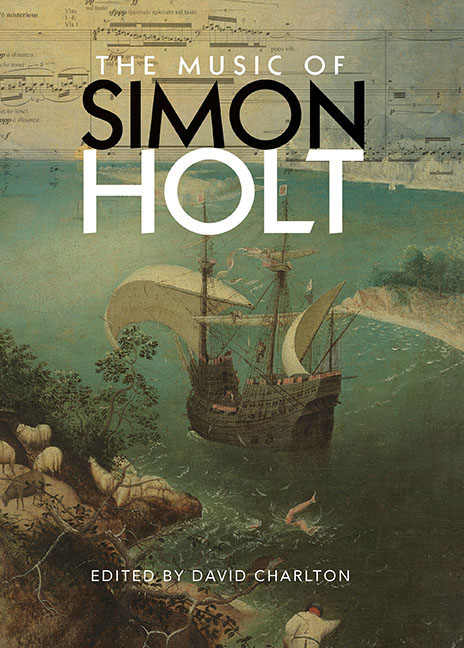Book contents
- Frontmatter
- Contents
- Figures and Tables
- Contributors
- Preface and Acknowledgements
- Abbreviations, with a note on recordings and scores
- Introduction Memories of Magical Moonlight: Simon Holt's years as a composition student
- 1 Duende y Duelos: The Andalusian spirit in the Lorca settings
- 2 An Interplay of Passion and Spirit: The Nightingale's to Blame
- 3 Images in Sound: Movement, harmony and colour in the early music
- 4 Myth and Narrative in 3 for Icarus
- 5 Sound, Sense and Syntax: The Emily Dickinson settings
- 6 Piano Music
- 7 Redefining the Cello's Voice: Musical agency in feet of clay
- 8 Performance and Reflections: Holt's music for oboe and cor anglais
- 9 Shaking the Bars: The Yellow Wallpaper
- 10 Listening to the River's Roar: Stance, texture and space in the concertos
- 11 Orchestral Works in Performance
- 12 Oblique Themes and Still Centres: A conversation between
- 13 Sketching and Idea-Gathering
- 14 Art, Conceptualism and Politics in Holt's music
- Appendix A Overview and Catalogue of Pieces
- Appendix B Texts by Simon Holt for Raju Raghuvanshi is a ghost and The Legend of Melusine
- Bibliography
- Index of pieces by Simon Holt
- General index
13 - Sketching and Idea-Gathering
Published online by Cambridge University Press: 01 September 2018
- Frontmatter
- Contents
- Figures and Tables
- Contributors
- Preface and Acknowledgements
- Abbreviations, with a note on recordings and scores
- Introduction Memories of Magical Moonlight: Simon Holt's years as a composition student
- 1 Duende y Duelos: The Andalusian spirit in the Lorca settings
- 2 An Interplay of Passion and Spirit: The Nightingale's to Blame
- 3 Images in Sound: Movement, harmony and colour in the early music
- 4 Myth and Narrative in 3 for Icarus
- 5 Sound, Sense and Syntax: The Emily Dickinson settings
- 6 Piano Music
- 7 Redefining the Cello's Voice: Musical agency in feet of clay
- 8 Performance and Reflections: Holt's music for oboe and cor anglais
- 9 Shaking the Bars: The Yellow Wallpaper
- 10 Listening to the River's Roar: Stance, texture and space in the concertos
- 11 Orchestral Works in Performance
- 12 Oblique Themes and Still Centres: A conversation between
- 13 Sketching and Idea-Gathering
- 14 Art, Conceptualism and Politics in Holt's music
- Appendix A Overview and Catalogue of Pieces
- Appendix B Texts by Simon Holt for Raju Raghuvanshi is a ghost and The Legend of Melusine
- Bibliography
- Index of pieces by Simon Holt
- General index
Summary
THERE ARE MYRIAD WAYS of approaching the task of inventing music successfully. This truth has become apparent during the years I have worked with fellow composers and talked to them, both professionals and students. Some composers vary their tack considerably from piece to piece, while others plough a familiar furrow, refining tried and trusted techniques through minor adjustments. Their processes are the subject of common curiosity: how does one get started? where do the ideas come from? how does a composer begin getting things down on paper? This chapter is an attempt to answer these questions in the context of Simon Holt's music, focusing on three works that cover different parts of his career. By looking at their starting points we shall see to what extent his approach has changed, perhaps because of the influence of different composers on his work, or through experience gained in a career spanning more than thirty-five years. I was fortunate to be able to base the research for this chapter not only on perusal of the composer's own sketches, but also on conversations with him. The results of our talks will be liberally quoted from; but, given the constraints of space, the descriptions that follow are no more than an introduction to the material.
These surviving sketches are of exceptional interest, not least in light of the argument that ‘sketch studies have become the condition sine qua non for the posing of valid analytical hypotheses’. The first piece under scrutiny is Kites (1983), for chamber ensemble. This was Holt's first major commission for the London Sinfonietta, who were eminent exponents of new chamber-orchestral music in Britain at this time. Based at the Southbank Centre in London, the orchestra had a reputation for curating programmes that balanced new works by internationally established composers with commissions from up-and-coming ones. A young composer could virtually establish a career by writing successfully for the Sinfonietta. Michael Vyner, as musical director of the orchestra, approached Holt and another debutant, Mark-Anthony Turnage, and asked them to write pieces for a concert that was also to feature the Benjamin Britten Sinfonietta. While being excited about the commission, Holt was at first concerned because the specified instrumentation (wind quintet plus string quintet) contained none of the resonating instruments that he loved to use, such as percussion, harp and piano.
- Type
- Chapter
- Information
- The Music of Simon Holt , pp. 261 - 283Publisher: Boydell & BrewerPrint publication year: 2017



